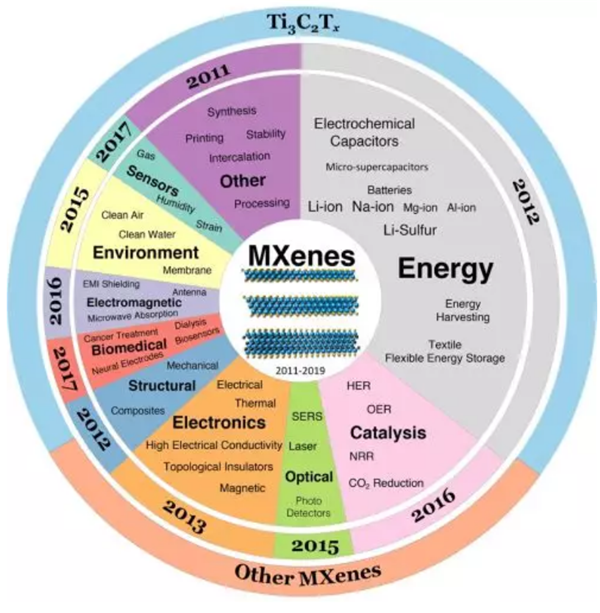ACS Nano Editorial: The rise of MXenes
QQ Academic Group: 1092348845
Detailed

In the past 15 years, layered two-dimensional (2D) materials have been extensively studied since the unique physical properties of single-layer graphene were discovered. Researchers have not only conducted a deeper study of known two-dimensional materials such as metal sulfides and boron nitride, but also discovered many novel two-dimensional materials. Although many of these two-dimensional materials are still in the theoretical research stage, their unique nature and development potential have attracted the research interest of many researchers. The most representative is the transition metal carbides and nitrides, which we call MXenes materials, is a rapidly developing 2D material system. In the two-dimensional nanostructure of MXene, the n+1 (n=1-3) layer is a transition metal M, which is staggered with n layers of carbon or nitrogen X, and has the general formula Mn+1XnTx. Tx in the formula represents a functional group bonded to the surface of the M atom layer, such as -O, -OH, -F and/or -Cl.

MXene has a unique combination of properties, including high conductivity and mechanical stability of transition metal carbides/nitrides; functionalization of MXene surfaces allows MXene to be more hydrophilic and promotes compounding with various materials. High negative potential, which can form stable colloidal solution in aqueous environment and effective absorption of electromagnetic waves. The application of the MXene material is summarized in the form of a pie chart in Figure 2. The second ring represents the year in which the first paper was published in each application area. Energy storage is the pioneering stone for exploring MXene applications, and it is still the focus of MXene materials research until now. Although MXene has only been used in biomedical research for only 2 years, it has become a hot topic in cancer research, such as photothermal therapy, therapeutic diagnosis, thermodynamics, biosensors, dialysis and nerve electrodes. MXene also plays an important role in electromagnetic applications. These include electromagnetic interference shielding and printable antennas. In other areas, including electronic and structural applications, most published research results are theoretical, with relatively few experimental papers, and many predictive properties, such as ferromagnetic or topological insulators, have not been experimentally performed. verification.

To date, more than 70% of MXene research papers have focused on the most typical MXene Ti3C2Tx. The exploration of MXene is so extensive that MXene has become synonymous with Ti3C2Tx for many researchers, unless otherwise stated. At least 100 chemically and experimentally proven MXene complexes with unique composite properties and countless solid solutions, the experimenter can adjust their composition by changing the ratio of M or X elements. A large number of unexplored MXene system materials have opened the door to new worlds due to their unique composition and structure for different fields of application. We believe that we are still at the beginning of MXene research, and many exciting discoveries will follow us. And coming one after another.
Literature link:
DOI: 10.1021/acsnano.9b06394
Source: WeChat public account MXene Frontier
- Previous: Bi-MOF-derived Bi mono
- Next: Review: Research progr


 Technology frontier
Technology frontier